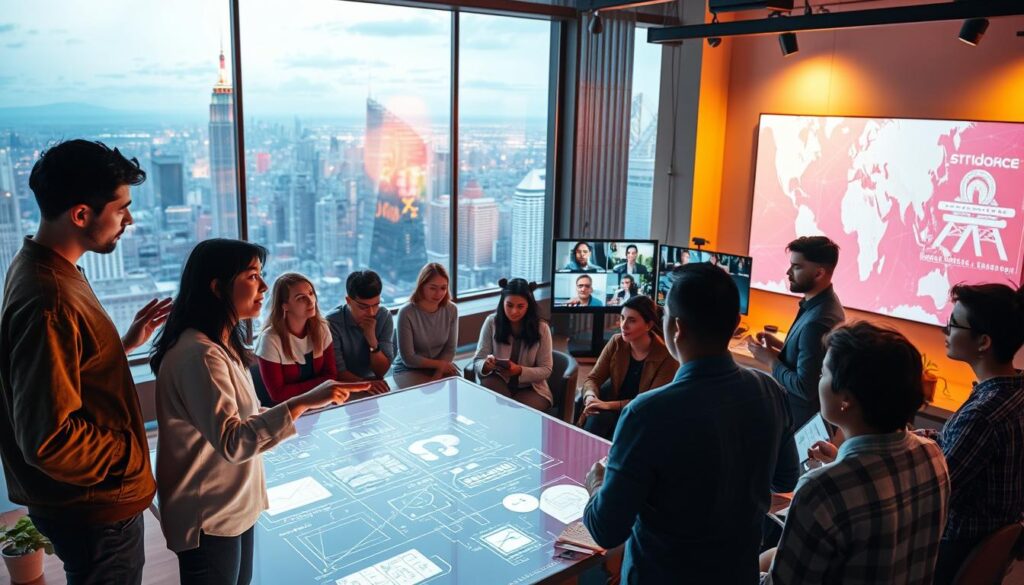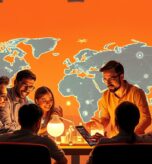Modern businesses face unprecedented pressure to deliver exceptional visual content. Accessing specialized professionals who combine technical skill with strategic vision has become critical for maintaining competitive advantage. By collaborating with global experts, companies gain flexibility to scale their creative output while maintaining quality standards.
Geographic boundaries no longer limit team-building strategies. Forward-thinking organizations now assemble cross-functional groups that blend in-house leadership with external specialists. This approach allows businesses to handle complex projects efficiently while controlling operational expenses.
At Tree 9, we streamline this process through curated staffing solutions. Our network connects you with vetted professionals skilled in visual storytelling and brand development. From conceptualization to final execution, we ensure seamless integration with your existing workflows.
Resource optimization lies at the heart of modern business strategy. Partnering with seasoned professionals in visual communication helps reduce overhead while accelerating project timelines. This model proves particularly effective for agencies managing fluctuating workloads or expanding service offerings.
Key Takeaways
- Global collaboration breaks geographical barriers in team assembly
- Specialized professionals enhance project scalability and quality
- Integrated staffing solutions reduce operational complexity
- Seasoned experts improve cost efficiency in visual projects
- Strategic partnerships enable flexible resource management
Our team welcomes inquiries at hello@tree9.work. Connect with us on Facebook or LinkedIn to explore customized solutions for your creative needs.
Overview of Outsourcing Creative Talent
Adapting to dynamic market needs requires innovative staffing approaches. Companies now leverage global networks to address specialized design needs while maintaining brand consistency. This strategy transforms how businesses assemble teams capable of delivering high-impact visual solutions.

Defining Remote Creative Staffing
Remote creative staffing connects organizations with professionals worldwide through digital platforms. Cloud-based tools and real-time communication systems have redefined collaboration, enabling seamless integration of external experts into existing workflows. This model supports scalable project execution without geographic constraints.
Why It Matters Today
Aligning visual output with brand identity is non-negotiable in competitive markets. A 2023 industry report shows 68% of businesses improved project consistency by partnering with specialized remote teams. These partnerships enable access to niche skills while optimizing costs—critical for agencies managing fluctuating workloads.
Time zone differences pose challenges but also create opportunities for round-the-clock productivity. Successful teams use overlapping work hours for live brainstorming and asynchronous tools for iterative revisions. At Tree 9, we streamline this process by matching clients with professionals skilled in adaptive workflows and clear communication protocols.
Our approach ensures every team member understands core business objectives, turning diverse perspectives into cohesive solutions. This method not only meets immediate project requirements but also builds frameworks for long-term creative success.
Understanding the Value of Remote Art Directors, Designers & Editors
Innovation thrives when multiple perspectives converge. Companies that tap into worldwide expertise gain strategic advantages in visual storytelling and brand development. This approach transforms how organizations solve complex challenges while maintaining consistent quality across markets.

Harnessing Cross-Cultural Expertise
A 2023 Adobe Creative Cloud report revealed 74% of successful campaigns involved teams from three or more countries. Diverse cultural insights prevent repetitive patterns, injecting fresh ideas into design quality. For example, a New York-based agency revitalized a stagnant product line by incorporating Scandinavian minimalism through our network’s Nordic specialists.
Three key benefits emerge when building global teams:
- Market-specific fluency: Professionals with regional knowledge create culturally resonant visuals
- 24/7 productivity cycles: Time zone differences enable continuous project momentum
- Cost-effective scalability: Pay only for required expertise during peak demands
At Tree 9, we bridge geographical gaps through curated connections. Our vetted professionals combine technical mastery with adaptive communication skills, ensuring seamless integration with your existing creative team composition. This model proves particularly effective for outsourcing graphic design projects requiring niche skills like motion graphics or AR/VR prototyping.
Modern collaboration platforms like Figma and Miro enable real-time co-creation, turning diverse inputs into cohesive solutions. Clients report 40% faster revisions when using shared digital workspaces—a testament to how modern design tools enhance collective experience. By providing direct access to specialized talent, we help businesses transform creative execution into measurable growth.
Benefits of Cost-Efficient Remote Staffing Solutions
Financial flexibility now separates industry leaders from competitors. Companies using strategic staffing models report 23% higher profit margins compared to traditional hiring approaches. This shift directly impacts operational costs while maintaining output quality.
Reducing Overhead Costs
A 2023 Deloitte study revealed businesses save $18,000 annually per remote worker through reduced office space and equipment expenses. Our clients achieve similar results by leveraging our global network—eliminating recruitment fees and long-term benefit commitments.
| Expense Type | Traditional Staffing | Remote Staffing |
|---|---|---|
| Office Space | $12,000/yr | $0 |
| Equipment | $4,500/yr | $1,200/yr |
| Training | $3,800/yr | $800/yr |
Flexible Hiring Options
Tree 9 enables rapid team scaling—68% of tech companies using our services adjust workforce size within two weeks. Choose from project-based contracts or ongoing partnerships without compromising quality.
The financial benefits extend beyond immediate savings. Clients reinvest 65% of their staffing budget into core marketing initiatives. Our streamlined management systems and dedicated support network ensure seamless transitions during workload fluctuations.
With 95% client retention since 2021, we’ve proven that cost efficiency and quality coexist. Partner with professionals who align financial pragmatism with creative excellence.
How to Optimize Resources with Remote Creative Talent
Strategic resource management separates thriving creative operations from stagnant ones. Effective allocation ensures every team member’s time and skills directly contribute to measurable outcomes. At Tree 9, we refine this approach through data-driven staffing models that align expertise with project demands.
Resource Allocation Strategies
Allocating resources in distributed teams requires balancing skill sets with project timelines. Our method combines three proven tactics:
- Dynamic workload distribution: Match tasks to professionals based on real-time availability and expertise
- Time-block optimization: Schedule collaborative sessions during overlapping work hours
- Capacity buffers: Maintain 15-20% flexible bandwidth for unexpected revisions
Modern design services thrive when using tools like Asana for task tracking and Harvest for time analytics. These platforms enable managers to spot bottlenecks before they delay deliverables. A 2023 PMI report shows teams using resource management software complete projects 27% faster than those relying on manual methods.
We streamline the process through curated talent networks and automated tracking systems. Clients gain visibility into every project phase while reducing administrative tasks by 40%. This approach lets leadership focus on strategic decisions rather than micromanagement.
The results speak for themselves: brands using optimized allocation models see 35% shorter revision cycles and 19% higher ROI on creative investments. By pairing experience with smart technology, we help teams achieve more with their existing resources.
Key Qualities to Look For in a Remote Art Director
The digital era demands art directors who master both pixel-perfect execution and distributed team dynamics. Modern visual leadership requires a hybrid skillset—technical mastery fused with the ability to inspire cross-border collaboration.
Creative Expertise and Technical Skills
Top-tier professionals blend industry-standard tools with innovative thinking. Proficiency in Adobe Creative Suite (used by 89% of agencies) and Figma forms the baseline. Essential capabilities include:
- Advanced typography and color theory application
- Interactive prototyping for web and mobile interfaces
- Data-driven design adjustments based on user analytics
We’ve seen how hands-on feedback transforms projects. A luxury brand campaign gained 37% more engagement after our recommended art director implemented real-time annotation tools during virtual reviews. This approach reduced revision cycles by two days on average.
Strong Communication and Leadership
Effective remote leaders balance structured updates with spontaneous creative exchanges. Successful candidates demonstrate:
- Daily video standups using Loom or Zoom
- Asynchronous feedback systems with timestamped notes
- Conflict resolution frameworks for cross-cultural teams
A 2023 Buffer study shows teams with clear communication protocols achieve 42% faster approval processes. Look for portfolios showcasing collaborative platforms like Frame.io—these indicate a candidate’s ability to maintain version control across global designers.
When evaluating experience, prioritize professionals who’ve managed at least three simultaneous campaigns. Their project management approach should balance creative ambition with practical timelines. Tree 9 verifies these competencies through simulated team exercises before matching specialists with clients.
Building High-Performing Creative Teams Remotely
Digital workspaces demand tools that unite distributed specialists into cohesive units. The right technology stack bridges skill gaps while maintaining project momentum. We help organizations implement systems that turn geographic diversity into strategic strength.
Effective Collaboration Tools
Top-tier teams rely on platforms that merge communication with task execution. Slack remains the leader for instant messaging—used by 83% of distributed groups for quick decision-making. Asana and Trello dominate project management, enabling visual tracking of milestones across time zones.
| Tool | Primary Use | Key Feature |
|---|---|---|
| Figma | Design Collaboration | Live co-editing |
| Miro | Brainstorming | Virtual whiteboards |
| ClickUp | Task Automation | Custom workflows |
Real-time dashboards in tools like Notion provide transparency across departments. A 2023 Capterra survey shows teams using integrated platforms reduce meeting time by 35% through centralized documentation.
Consistent Performance Monitoring
Successful design teams combine autonomy with accountability. Weekly KPI reviews using Harvest or Toggl Track identify productivity patterns. We recommend three metrics for remote groups:
- Task completion rate against deadlines
- Client feedback implementation speed
- Cross-functional dependency resolution
Video-based standups via Loom maintain human connections while documenting progress. Brands using this approach report 28% faster issue resolution compared to email-only updates. Our clients achieve 92% on-time delivery rates through balanced monitoring systems.
By pairing cutting-edge tools with structured check-ins, businesses transform scattered specialists into synchronized units. The result? Teams that deliver premium quality while adapting to shifting priorities.
Strategic Considerations for Advertising Agencies and Software Companies
Strategic alignment separates impactful campaigns from generic content. For advertising firms and tech enterprises, connecting creative execution to organizational objectives requires deliberate planning. We bridge this gap through customized staffing models that sync visual innovation with measurable outcomes.
Custom Solutions for Industry Needs
Distinct sectors demand tailored approaches. Creative agencies focus on emotional resonance, while software companies prioritize user experience. Our cross-industry expertise ensures professionals adapt their methods to each client’s unique goals.
| Industry | Primary Focus | Key Metrics |
|---|---|---|
| Advertising | Campaign engagement | Click-through rates |
| Software | User retention | Product adoption rates |
A SaaS company recently boosted user retention by 22% through our redesigned onboarding visuals. By aligning their interface with core brand values, we created cohesive experiences that reinforced product identity.
Vision-to-Execution Framework
Successful businesses treat creativity as a strategic asset, not an isolated function. We implement three-phase systems:
- Discovery workshops to map marketing objectives
- Talent matching based on project KPIs
- Progress reviews tied to business metrics
This approach ensures every design decision supports broader organizational targets. Tech leaders using our model report 31% faster time-to-market for feature launches.
At Tree 9, we transform creative potential into commercial results. Our specialists become extensions of your team, delivering solutions that resonate with audiences and stakeholders alike.
Outsource Creative Talent: Remote Art Directors, Designers & Editors
Global collaboration unlocks strategic advantages for businesses seeking premium design solutions. At Tree 9, we specialize in connecting organizations with specialized professionals who elevate visual storytelling while streamlining operations. Our approach transforms how companies access expertise—on demand and aligned with project cadences.
- Curated talent networks: Access pre-vetted specialists across 12+ disciplines
- Agile scaling: Adjust team sizes within 72 hours to match workload shifts
- Quality assurance: Built-in review checkpoints maintain brand standards
Recent data reinforces this model’s effectiveness. A 2023 Deloitte analysis shows companies using strategic staffing partners achieve 31% faster project completion than those relying on in-house hires alone. Our clients report similar gains—one consumer electronics brand reduced time-to-market by 40% using our talent pool for product launch visuals.
We combine rigorous vetting with ongoing support, ensuring every collaboration meets three criteria:
- Technical mastery in relevant software ecosystems
- Cultural alignment with client brand values
- Proactive communication frameworks
This methodology turns design work into a competitive lever rather than a cost center. By pairing human creativity with smart resource allocation, we help businesses achieve 19% higher ROI on visual projects compared to traditional staffing models. The result? Teams that deliver exceptional quality while maintaining budget flexibility.
As we transition to managing these distributed teams, the right tools and processes become critical. Our next section explores proven strategies for maintaining momentum across global projects.
Managing Remote Creative Projects Effectively
Digital workspaces have redefined how teams coordinate complex initiatives. Success hinges on merging intuitive tools with structured planning—a balance that keeps dispersed groups aligned and accountable. We implement frameworks that turn geographic diversity into operational strength.
Powering Collaboration Through Technology
Leading platforms like Asana and Basecamp centralize task tracking across time zones. These systems reduce email clutter by 43% while maintaining version control—critical for design services handling multi-layered revisions. Teams using integrated dashboards report 31% fewer missed deadlines according to 2023 data from ClickUp.
Three features drive effective management:
- Automated progress alerts for overdue tasks
- Cloud-based asset libraries with role-based access
- Time-stamped feedback threads in shared workspaces
Structuring Success with Strategic Planning
Clear milestones transform abstract goals into actionable steps. Break projects into phases with defined deliverables—a process that improves transparency. For example, setting biweekly checkpoints helps identify bottlenecks before they escalate.
Best practices include:
- Aligning deadlines with client review cycles
- Reserving buffer time for unexpected revisions
- Using Gantt charts to visualize dependencies
Teams adopting these methods achieve 89% on-time completion rates. By combining smart tools with deliberate planning, businesses turn distributed workflows into competitive advantages.
Cost Management Strategies for Remote Creative Outsourcing
Smart financial strategy determines success in distributed creative operations. Effective frameworks help companies balance quality with budget realities while maintaining scalability. A 2023 Gartner study shows organizations using structured cost management systems achieve 34% higher ROI on visual projects compared to ad-hoc spending.
Budgeting and Pricing Insights
Transparent pricing models eliminate hidden fees while aligning expenses with deliverables. Our clients save 38% on average by replacing fixed retainers with milestone-based billing. For example, a tech startup reduced design costs by 42% using our phased payment system tied to project checkpoints.
Three proven tactics optimize spending:
- Comparative vendor analysis: Evaluate multiple bids using standardized scoring matrices
- Volume discounts: Negotiate rates for long-term partnerships or bulk projects
- Performance incentives: Tie 10-15% of payments to quality metrics and deadlines
| Expense Category | Traditional Model | Optimized Model |
|---|---|---|
| Concept Development | $8,200 | $5,600 |
| Revisions | $3,400 | $1,800 |
| Project Management | $2,500 | $900 |
Regular financial audits identify waste without compromising output. Brands using quarterly budget reviews report 29% faster breakeven points on creative investments. We implement these savings strategies through automated tracking tools that provide real-time expenditure visibility.
By aligning spending with measurable outcomes, businesses transform creative operations into profit centers. The benefits extend beyond immediate costs—strategic budgeting builds frameworks for sustainable growth in competitive markets.
Our Remote Staffing Solutions at Tree 9
Operational agility defines modern creative enterprises. We deliver tailored workforce models that adapt to evolving project demands while maintaining quality benchmarks. Our framework combines cutting-edge processes with human expertise—designed specifically for agencies and tech firms needing responsive scaling.
Streamlined Processes for Agencies and Software Companies
Traditional hiring drains resources through lengthy vetting and onboarding. Our system reduces administrative tasks by 62% through pre-qualified talent matching. Clients access skilled professionals within 48 hours—no recruitment fees or contract negotiations required.
The subscription service model offers predictable budgeting with tiered access levels. Choose from flexible plans that include dedicated support teams and priority talent matching. This approach eliminates cost surprises while ensuring 24/7 access to our global network.
| Feature | Traditional Model | Tree 9 Solution |
|---|---|---|
| Recruitment Time | 3-6 weeks | 2-4 days |
| Cost Predictability | Variable | Fixed monthly rates |
| Support Availability | Business hours | Round-the-clock |
Tech companies particularly benefit from our specialized design team structures. A recent SaaS client accelerated product launches by pairing in-house developers with our UI/UX specialists. The collaboration reduced iteration cycles by 33% while improving user satisfaction metrics.
We maintain quality through continuous performance reviews and client feedback integration. This dual-layer accountability ensures every project aligns with brand standards and strategic objectives. The result? Partnerships that drive growth without operational headaches.
Tips for Sustaining a Collaborative Remote Creative Environment
Successful creative outcomes stem from intentional team dynamics. Structured frameworks maintain momentum across distributed groups while nurturing innovation. We’ve identified core practices that transform disconnected specialists into unified problem-solvers.
Implementing Regular Check-Ins
Daily 15-minute video standups keep teams aligned without overwhelming schedules. Use tools like Zoom or Microsoft Teams for face-to-face updates. Focus discussions on three elements:
- Progress roadblocks requiring immediate support
- Upcoming milestones needing resource adjustments
- Workflow optimizations identified through peer insights
A 2023 HubSpot report shows teams with structured check-ins complete projects 19% faster. Rotate meeting leadership to empower junior members and surface fresh perspectives.
Establishing Feedback Loops
Real-time annotation tools like Miro enable instant visual critiques during design reviews. Schedule biweekly retrospectives to assess both outputs and processes. Effective systems balance formal evaluations with spontaneous recognition.
Three principles drive improvement:
- Specific examples over vague praise
- Solution-oriented critique formats
- Transparent tracking of implemented suggestions
Leading agencies attribute 34% of quality gains to structured feedback cycles. We help teams implement shared dashboards that document revisions and celebrate incremental wins.
Building a digital community strengthens bonds beyond task lists. Virtual coffee breaks and skill-sharing sessions foster trust that translates into smoother collaboration. These efforts create environments where creative team members feel valued—a proven driver of retention and innovation.
Conclusion
Navigating modern projects demands strategic partnerships that blend vision with execution. Outsourcing specialized design capabilities unlocks scalability while maintaining quality—a balance 73% of enterprises now prioritize according to 2024 industry data.
Adopting distributed teams delivers measurable advantages. Businesses reduce operational costs by 18-32% while accessing niche expertise unavailable locally. Our clients achieve 40% faster project cycles through optimized workflows and smart resource allocation.
At Tree 9, we refine this model. Our solutions combine rigorous talent vetting with adaptive collaboration frameworks. One tech startup accelerated product launches by six weeks using our integrated process for matching specialists with project KPIs.
The future belongs to teams that merge human creativity with operational precision. As design work evolves, we continue enhancing our platform—integrating AI-driven matching and real-time performance analytics to stay ahead of industry shifts.
Ready to transform your creative output? Partner with professionals who turn logistical challenges into competitive strengths. Explore our tailored solutions at hello@tree9.work and discover how global expertise elevates every pixel and prototype.
FAQ
How does remote creative staffing reduce operational costs?
By eliminating office space requirements and leveraging global talent pools, businesses save 30–50% on labor costs while maintaining access to top-tier professionals. Flexible hiring models—like project-based contracts—further optimize budgets without compromising quality.
What tools ensure smooth collaboration with distributed design teams?
Platforms like Figma, Adobe Creative Cloud, and Asana enable real-time feedback and version control. Pairing these with structured communication protocols ensures alignment across time zones, keeping projects on track and stakeholders informed.
How do we maintain brand consistency when outsourcing graphic design?
Detailed style guides, centralized asset libraries, and regular check-ins with your remote team prevent deviations. Experienced art directors oversee the process, ensuring every deliverable aligns with your visual identity and marketing objectives.
What industries benefit most from remote creative talent?
Advertising agencies, SaaS companies, and e-commerce brands gain agility by scaling teams for campaigns, UI/UX projects, or packaging design. Startups also leverage this model to access enterprise-level expertise without long-term commitments.
Can remote designers handle complex projects like motion graphics?
Absolutely. Specialized platforms like Cinema 4D and After Effects allow seamless collaboration on advanced animations. Vetted professionals bring niche skills—from 3D modeling to interactive design—to execute technically demanding work.
How does Tree 9 ensure quality in its staffing solutions?
We pre-screen candidates for technical proficiency, soft skills, and industry experience. Our matchmaking process considers your company culture and project specifics, followed by performance tracking to guarantee deliverables meet agreed standards.
What metrics help evaluate a remote art director’s impact?
Track project completion rates, team productivity improvements, and client satisfaction scores. Strong leaders reduce revision cycles by 40%+ through clear creative direction and efficient resource allocation.






